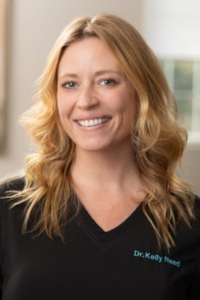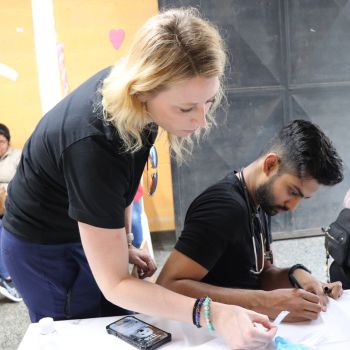Finding My Place in Medicine
Published September 16, 2025
Inside OME

By Kelly Reed, DO, FAAD, FACMS, FAOCD, board certified dermatologist and fellowship trained Mohs micrographic surgeon
Even after years of training, as a woman physician I sometimes still hear the same question.
“Excuse me, is the doctor here yet?”
I’ve lost track of how many times I’ve been asked that question, often while I’m standing right there, introducing myself as the physician. Early on, it stung. How could years of sacrifice, study and sleepless nights be overlooked in an instant? But over time, I’ve learned that every moment like this is a chance to redefine what a doctor looks like and to remind myself that I belong in the room.
My path to medicine began in Marble Hill, Missouri, a small town near Cape Girardeau. I didn’t grow up around physicians. What I did grow up with was curiosity, resilience and a desire to help people. Those qualities led me to Kansas City University (KCU), where I began my osteopathic medical education.
From the first day, the osteopathic philosophy resonated: treat the whole person, not just the disease. We trained with our hands, palpating subtle differences in tissue, learning to sense health and dysfunction beneath the surface. That skill now defines my specialty, dermatology and Mohs micrographic surgery, where the difference between normal and abnormal skin can be measured in millimeters. My osteopathic foundation gave me confidence to trust my touch and see my patients as whole people, not just conditions.
But what shaped me most were the mentors who pulled me in, often when I was the only woman in a group of men. During my dermatology residency, there were five men and me. Walking into rooms of all male colleagues wasn’t easy, and I had to learn how to speak up, to take space and to trust my training.
.jpg?sfvrsn=af4898cd_1)
Mentors made all the difference. Cynthia Bartus, MD, one of my Mohs surgery mentors (pictured left), not only sharpened my surgical skills but also showed me by the way she led her practice that women belong at the head of the table. Her example gave me permission to take space, to speak with confidence and to believe in my own training.
That belief now shapes my care. Patients don’t always expect the doctor to be a woman, but they quickly learn that being a physician isn’t about gender. It’s about knowledge, empathy and the ability to meet people where they are.
Osteopathic medicine deepens that presence. I don’t just ask about a rash or a lesion; I ask about sleep, stress and nutrition. I’ll never forget a patient with atopic dermatitis who had tried everything, in tears at every visit. By talking about his coping mechanisms, including drinking to manage stress, we uncovered a root cause. When he stopped, his skin cleared. That’s the power of osteopathic, whole-person care.

My career has also taken me far beyond my clinic walls. Through the global health track at KCU, I’ve traveled to Guatemala nearly a dozen times (pictured right) and once to Kenya, caring for patients in underserved communities. I remember the dusty roads lined with families who walked for hours just to be seen. In those settings, I get to be both physician and teacher, guiding medical students as they take their first brave steps into medicine. Their eagerness reminds me of my own beginnings, and their resourcefulness renews my faith in the future of our profession.
Balancing all of this — career, patients, global health and raising my son — hasn’t been easy. Burnout is real. Protecting my own well-being has meant salsa dancing and making space for joy. These choices don’t take away from my identity as a physician; they make me better for my patients.
To young women in medicine, especially those considering osteopathic training or competitive specialties like dermatology, I’d say this: fear is not a stop sign. It often points to the exact path you’re meant to take. Push through. Your best life and the best care you’ll give is waiting on the other side.

Today, whether I’m standing in an operating room, a clinic in Guatemala or a classroom full of students, I carry this truth:
I am the doctor in the room.
I am the teacher, the surgeon, the advocate.
And for the women coming behind me, I am proof that they belong, too.
